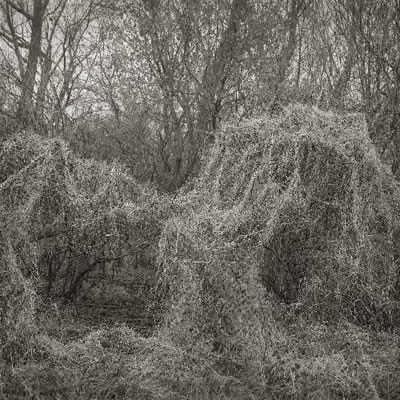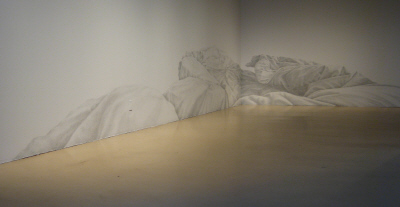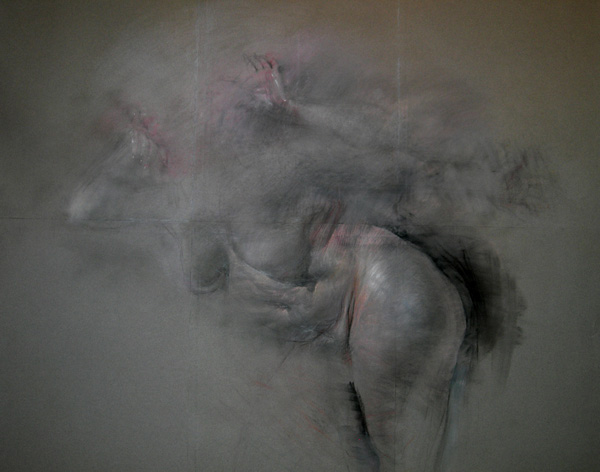In Review: In the Realm of the Senses
This collection of review excerpts is featured in the August issue of 10,000 arts, our quarterly print digest published in partnership with the Rake. Click the links to read the original reviews.




What is it we wish from fieldwork or a field of view? Beth Dow prunes the romantic notion of the artist-above-nature with the punctum of an enlightened gardener. Despite straightforward appearances, her work teems with history and philosophy in a comforting, meditative way, like gardens of the sublime domesticated and available for personal consultation.
Nineteen or so sixteen-inch square plots of palladium prints, with their large tonal range, show patterns not fully visible to our colored, roving eyes. Dow guides us through spaces that are not a black and white, but rather suffused with gray hovering mists, and positions our field of view within them. Perhaps here we can find our simple wish: to wonder at the presence of infinity and singularity.
Speaking of presence, Dow has said that Led Zeppelin IV was an early influence—“something ominous.” And it seems that mood is part of the existential drama at the roots of her work. The cover art for that album shows a country man hunched over by a large bundle of sticks, propping himself up with one: a gesture of self-assertion. It’s an image that shows interdependency between humanity and nature, like many of the gestures recorded in Dow’s landscapes. —Sean Smuda, from “Complicated Grey Eyes,”a review of Fieldwork by Beth Dow at Franklin ArtWorks
David Lefkowitz has long explored the topic of human intervention upon nature. Tangle builds on an earlier series of work called Flora: Introduced Species, which also put a microscope to the oil-and-water relationship between technology and nature. But in Tangle Lefkowitz takes the expanding conflict one step further. Not content with his repurposed type of genre painting or the ongoing human-versus-nature wrestling match, Lefkowitz gives yet another twist to his critical knife. Unlike the previous Flora works, the backgrounds of the paintings in the Tangle series are no longer simply neutral fields for the conflict. Here, some have been painted to suggest an endless sea or a timeless, eternal space glowing with light and atmosphere (heaven?). Others depict a grainy, out-of-focus background, as if the works were not paintings at all, but common photographic snapshots, legitimizing the conflict as real.
Also, by painting weeds, plants known for their rampant growth, instead of more exotic flora, Lefkowitz constructs a parallel narrative to the out-of-control growth of technology. If initially these paintings seduce through their veneer of beauty and an offhand sense of humor, their dark side quickly subverts this appeal. “We may be beautiful and full of artifice,” they seem to suggest, “but this conflict is real.” It is no longer so easy to see where nature stops and human engineering begins. —Mason Riddle, from
“Unnatural Nature,” a review of Tangle by David Lefkowitz at Thomas Barry Fine Arts
Paper icebergs; tree stumps made of cardboard; little cartoon woodland scenes in ceramic and felt; a biomorphic scatter of machine-made forms; a landscape of fully interchangeable smooth white parts; another landscape of giant bedclothes, limned delicately along a plaster wall.
Nature still lends its forms to these artworks, but it’s experienced as mediation, as a made thing.
This used to be news. Twenty years ago it was Baudrillard’s news, Lyotard’s news. These French thinkers wrote that we now live in a fully mediated world, that of the simulation, the world where there’s always a scrim of human culture between us and the big world that was here before humans existed. In fact, the scrim is so thick we can’t really even tell whether there’s anything else out there. The things that we take for granted as our environment—what you might call the ground of existence, the given—are all apparently human, now.
At a panel discussion of the show, when one of the artists spoke of driving up the North Shore and seeing the environment of trees and scrub as being not very appealing and, well, “messy,” it became even more apparent that the art world is fully encased in a solipsistic universe, eating and creating culture.
Artists, of course, haven’t created this situation, but they do report on it. The show is an affecting and effective report from the changing boundary between nature and human culture. It’s witty and amusing, and also, from the standpoint of this somewhat misanthropic treehugging critic, terribly sad.
The world in which icebergs come from National Geographic photos and forest landscapes come from Disney cartoons, and where our closest contact with trees is through our use of their macerated flesh in cardboard cartons and printer paper, is very much the real one. We might wish it wasn’t, but the first step toward fulfilling that wish to realize that it is. —Ann Klefstad, from
“Our Invented World(s)”: a review of Environments of Invention at the Minnesota Museum of American Art, featuring work from Holly Anderson Jorde, David Lefkowitz, Cherith Lundin, Liz Miller, Erika Olson, and Margaret Pezalla-Granlund
I am particularly taken with Anne Harris’s drawings, a literal body of work. Harris has drawn her own body in studies “of gravity and inner space.” These are fleshy images, often in large formats, and succeed tremendously at showing the viewer the nature of the physicality of being a woman, compounded by a kind of transparency—that of never really being able to objectively evaluate oneself. Harris says, “I don’t know what I look like anyway,” and her grid of dozens of small portraits featuring only her face and head are testament to this impossibility.
Women have consistently struggled with representation and in today’s world of digital manipulation, it is common for even Oprah, that paragon of “woman-ness,” to have her images digitally slimmed. Art in itself has become about fashion, and how the female artist looks sometimes competes with the content of her art. Harris’s heavy and sagging studies challenge this societal expectation of perfection. It is relieving to find her bodies more about a state of mind—how do I feel inside my body—than a statement of contemporary beauty. …
There is an obsessive quality to all the work in this show—whether writing endless lines with henna, paring the human form into basic shapes, creating meticulous reproductions or drawing lines of shifting human form—that gives the viewer an enormous amount to consider, with the eyes, heart, and mind. Laurel Reuter has put together a provocative exhibition that deserves to be seen by a wider audience. Which means, readers, we need to get out of our little worlds and get ourselves to the other side of the state. The best art no longer happens in the big cities—thanks to tenacious curators like Reuter. –Suz Szucs, from “Light Shed on the Body,” a review of Beyond Likeness, a show by Ann Harris, Elizabeth King, Jennifer Onofrio, and Lalla Essaydi at the North Dakota Museum of Art in Grand Forks